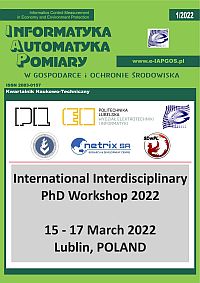OPTIMISATION OF COMMERCIAL BUILDING MANAGEMENT PROCESSES USING USER BEHAVIOUR ANALYSIS SYSTEMS SUPPORTED BY COMPUTATIONAL INTELLIGENCE AND RTI
Article Sidebar
Open full text
Issue Vol. 12 No. 1 (2022)
-
METHODS FOR ENSURING DATA SECURITY IN MOBILE STANDARDS
Serhii Moroz, Anatolii Tkachuk, Mykola Khvyshchun, Stanislav Prystupa, Mykola Yevsiuk4-9
-
HYBRID NAVIGATION SYSTEM FOR INDOOR USE
Michał Styła, Przemysław Adamkiewicz10-14
-
INDOOR LOCALIZATION SYSTEM USING UWB
Dominik Gnaś, Przemysław Adamkiewicz15-19
-
APPLICATION OF CONVOLUTIONAL NEURAL NETWORKS IN WALL MOISTURE IDENTIFICATION BY EIT METHOD
Grzegorz Kłosowski, Tomasz Rymarczyk20-23
-
TILTED FIBER BRAGG GRATING SENSORS FOR REFRACTIVE INDEX MEASUREMENTS OF LIQUID SOLUTIONS
Damian Harasim24-27
-
OPTIMISATION OF COMMERCIAL BUILDING MANAGEMENT PROCESSES USING USER BEHAVIOUR ANALYSIS SYSTEMS SUPPORTED BY COMPUTATIONAL INTELLIGENCE AND RTI
Michał Styła, Przemysław Adamkiewicz28-35
-
Development of deposition technology and AC measurement of copper ultrathin layers
Aleksandra Wilczyńska, Karolina Czarnacka, Andrzej Kociubiński, Tomasz Kołtunowicz36-39
-
NEURAL NETWORKS FROM KERAS IN SKIN LESION DIAGNOSTIC
Magdalena Michalska-Ciekańska40-43
-
DETERMINING THE WORKING LENGTH OF A ROOT CANAL USING INTRAORAL RADIOGRAPHY SEGMENTATION
Oleksii Perepelytsia, Tetyana Nosova44-46
Archives
-
Vol. 14 No. 4
2024-12-21 25
-
Vol. 14 No. 3
2024-09-30 24
-
Vol. 14 No. 2
2024-06-30 24
-
Vol. 14 No. 1
2024-03-31 23
-
Vol. 13 No. 4
2023-12-20 24
-
Vol. 13 No. 3
2023-09-30 25
-
Vol. 13 No. 2
2023-06-30 14
-
Vol. 13 No. 1
2023-03-31 12
-
Vol. 12 No. 4
2022-12-30 16
-
Vol. 12 No. 3
2022-09-30 15
-
Vol. 12 No. 2
2022-06-30 16
-
Vol. 12 No. 1
2022-03-31 9
-
Vol. 11 No. 4
2021-12-20 15
-
Vol. 11 No. 3
2021-09-30 10
-
Vol. 11 No. 2
2021-06-30 11
-
Vol. 11 No. 1
2021-03-31 14
-
Vol. 10 No. 4
2020-12-20 16
-
Vol. 10 No. 3
2020-09-30 22
-
Vol. 10 No. 2
2020-06-30 16
-
Vol. 10 No. 1
2020-03-30 19
Main Article Content
DOI
Authors
przemyslaw.adamkiewicz@cbrti.pl
Abstract
The aim of the presented project was to create a comprehensive building management system equipped with a network of wireless and energy-efficient sensors that collect data about users and on their basis control final devices such as lighting, ventilation, air conditioning and heating. In the presented system, end devices can be both products offered by the market (commercial) and proprietary solutions (own). This is to allow the adaptation of commercial radio communication protocols with high integration capabilities and common occurrence. In addition, the system has been enriched with an innovative system of tracking and building navigation and access control, which are supported by a network of radio beacons and radio-tomographic imaging technology (RTI). The whole system is to be supervised by computational intelligence learned from scratch.
Keywords:
References
Bluetooth SIG. Bluetooth Core Specification, version 4.0.; Bluetooth SIG: Kirkland, WA, USA, 2010.
Cavallini A.: iBeacons Bible, 2015.
Corna A., Fontana L., Nacci A. A., Sciuto D.: Occupancy detection via ibeacon on android devices for smart building management. Proceedings of the Design, Automation & Test in Europe Conference & Exhibition (DATE), 2015, 629–632. DOI: https://doi.org/10.7873/DATE.2015.0753
Havard N., McGrath S., Flanagan C., MacNamee C.: Smart Building Based on Internet of Thing Technology. Proceedings of the 12th International Conference on Sensing Technology (ICST), 2018. DOI: https://doi.org/10.1109/ICSensT.2018.8603575
Kozłowski E., Mazurkiewicz D., Żabiński T., Prucnal S., Sęp J.: Machining sensor data management for operation-level predictive model. Expert Syst. Appl. 159, 2020, 1–22. DOI: https://doi.org/10.1016/j.eswa.2020.113600
Liu H., Darabi H., Banerjee P., Liu J.: Survey of wireless indoor positioning techniques and systems. IEEE Trans. Syst. Man Cybern. Part C Appl. Rev. 37, 2007, 1067–1080. DOI: https://doi.org/10.1109/TSMCC.2007.905750
Matteuchi M.: An Adaptive Indoor Positioning System Based on Bluetooth Low Energy RSSI. Politecnico di Milano, Milano 2012.
Montgomery D. C., Peck E. A., Vining G. G.: Introduction to Linear Regression Analysis. World Scientific Publishing, Singapore 2012.
Node-RED Guide. Available online: http://noderedguide.com/ (accessed on 19.02.2022).
Peng Y., Rysanek A., Nagy Z., Schlter A.: Using machine learning techniques for occupancy-prediction-based cooling control in office buildings. Appl. Energy 211, 2018, 1343–1358. DOI: https://doi.org/10.1016/j.apenergy.2017.12.002
Postolache O. A., Dias Pereira J. M., Silva Girao P. M. B.: Smart Sensors Network for Air Quality Monitoring Applications. IEEE Trans. Instrum. Meas. 58, 2009, 3253–3262. DOI: https://doi.org/10.1109/TIM.2009.2022372
Rivera-Illingworth F., Callaghan V., Hagras H.: Automated Discovery of Human Activites inside Pervasive Living Spaces. Proceedings of the International Symposium on Pervasive Computing and Applications, 2006, 77–82. DOI: https://doi.org/10.1109/SPCA.2006.297520
Rymarczyk T., Kozłowski, E., Kłosowski G., Niderla, K.: Logistic Regression for Machine Learning in Process Tomography. Sensors 19, 2019, 3400. DOI: https://doi.org/10.3390/s19153400
Styła M., Oleszek M., Rymarczyk T., Maj M., Adamkiewicz P.: Hybrid sensor for detection of objects using radio tomography. Applications of Electromagnetics in Modern Engineering and Medicine, PTZE, 2019, 219–233. DOI: https://doi.org/10.23919/PTZE.2019.8781693
Suykens, J.A., Vandewalle J.: Least squares support vector machine classifiers. Neural Process. Lett. 9, 1999, 293–300. DOI: https://doi.org/10.1023/A:1018628609742
Tragos E. Z., Foti M., Surligas M., Lambropoulos G., Pournaras S., Papadakis S., Angelakis V.: An IoT based intelligent building management system for ambient assisted living. Proceedings of the IEEE International Conference on Communication Workshop (ICCW), 2015, 246–252. DOI: https://doi.org/10.1109/ICCW.2015.7247186
Article Details
Abstract views: 337
License

This work is licensed under a Creative Commons Attribution-ShareAlike 4.0 International License.






